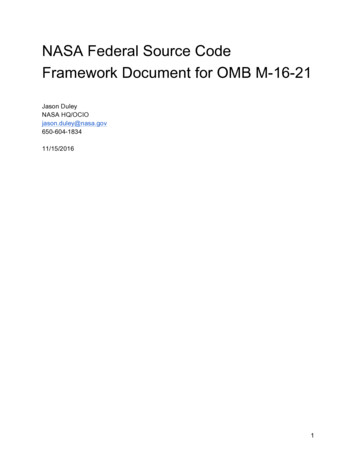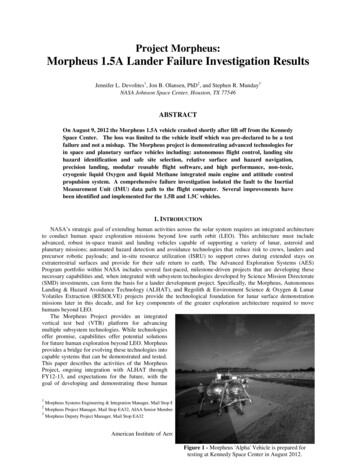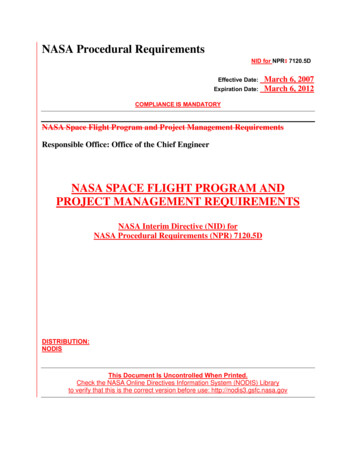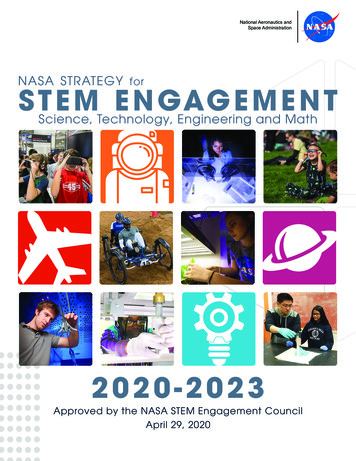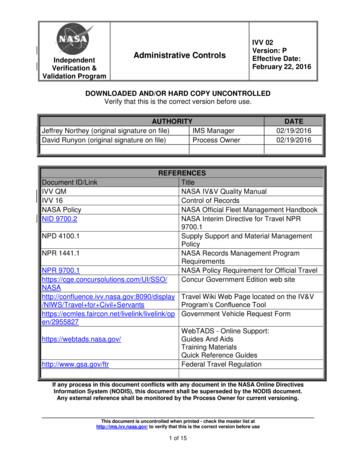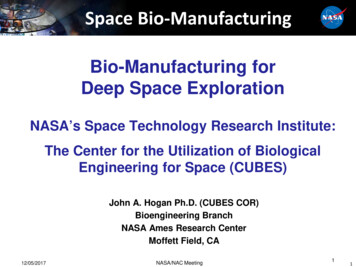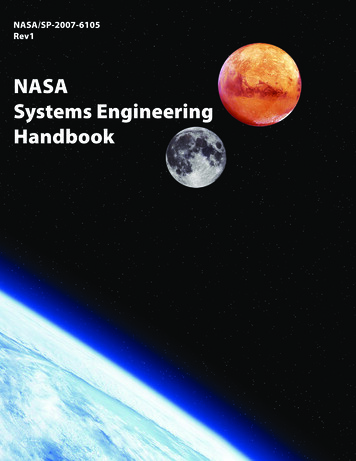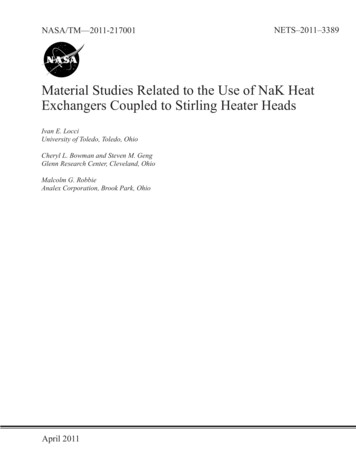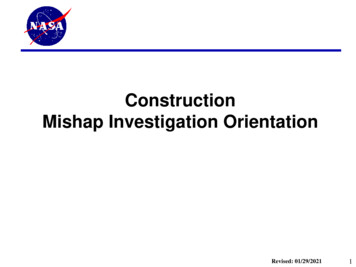
Transcription
ConstructionMishap Investigation OrientationRevised: 01/29/20211
Welcome to Your New JobInvestigating MishapsThe explosion of a Titan IVA with a NRO satellite in August 1999 was caused by wiring defects.Titan IV quality defects were linked to the overemphasis on cost cutting and the loss of experienced personnel.Source: General Tattini, ELV Payload Safety Conference 20042
Agenda NPR 8621.1 OverviewWhat’s a MishapWhat’s not a MishapClassification of MishapsWhat Happens After a Mishap OccursConstruction Mishap InvestigationNotional Investigation TimelineTwo Types of Mishap InvestigationsPurpose of Safety InvestigationInvestigating AuthorityProducts of Investigation – Report ContentsAfter Report is Authorized for ReleaseOverview of Investigation ProcessPre-Field PhaseField PhaseData CollectionSignature Page3
NPR 8621.1: Mishap Reporting,Investigating and Recordkeeping Overview Describes how to respond to a mishap and close call from discoverythrough corrective action closure. Includes:–––––––Descriptions of roles and responsibilitiesHow to classify mishaps (based on dollar loss, injury and visibility)How to establish an investigating authorityHow to perform an investigations & generate a reportHow to endorse a report and authorize it for public releaseHow to complete corrective actions and generate lessons learnedHow to retain recordsThe purpose of NASA mishap investigation process is todetermine cause and develop recommendations to prevent recurrence.4
What’s A Mishap?What’s A Close Call?NASA Mishap:An unplanned event that results in at least one of the following:a. Occupational Injury/illness to NASA/non-NASA personnel, caused by NASAoperations.b. Destruction of/damage to property (NASA, public, private or foreign property),caused by NASA operations or NASA-funded development or researchprojects.c. NASA mission failure before the scheduled completion of the plannedprimary mission.Close Call:An unplanned event in which there is no injury or only minor injuryrequiring first aid, no damage or minor damage (less than 20,000) toequipment or property or both, but which possesses a potential to causea mishap.ALL MISHAPS and CLOSE CALLS ARE INVESTIGATEDNASA reserves the right to be the lead for mishap investigations of mishaps defined above.5
What’s Not A Mishap?The following are not considered NASA Mishaps or Close Calls:a. Illnesses or fatalities resulting from natural causes or those unrelated to thework environment when disease, not injury, is the cause of lost time (e.g.,diabetes and resultant complications, loss of vision).b. Intentional self-inflicted injuries or fatality.c. Injuries or fatalities resulting from altercations, attack, assault - unlessincurred in the performance of official duties such as criminal investigations orhomicide.d. Destruction of or damage to any property (public, private, or Government)onsite at a Center or involving NASA property on grounds outside Centerproperty as a direct result of any of the following: Weather conditions such as hurricane, lightning, tornado, high winds, dust storm, tidalwave, tsunami, waterspout, or ice or snow loads, Natural phenomena such as flood, landslide, earthquake, meteoroid landing, or volcaniceruption, Wild fire, Vandalism, riot, civil disorder, or felonious act such as arson or, in some cases, theft.6
What’s Not A Mishap?The following are not considered NASA Mishaps or Close Calls(continued):e. Accidents occurring during the transportation of NASA material bycommercial carriers when NASA or NASA contractors had no roles orresponsibilities for packing, securing, or transporting the items.f. A malfunction or failure of component parts that are normally subject to fairwear and tear and have a fixed useful life that is less than the completesystem or unit of equipment. This only applies if there was adequatepreventative maintenance and the malfunction or failure was the onlydamage, and the sole action is to replace or repair that component. Inaddition, there must not have been a malfunction or failure of a componentpart that resulted in damage to another component, the facility or injury topersonnel.g. Accidents involving aircraft operated as civil use, owned by civil operators,and accomplishing contract air missions for NASA where there is no NASAproperty damage or Federal employee injury.7
How are Mishaps Classified? Classification based on dollar loss and injury.(Mission failure based on cost of mission failure). Classification determines type of investigation tobe conducted. Mishap Classification Table– Type A Mishaps – Type D Mishaps– Close CallsNOTE:Include the Mishap’s Classification, Dollar Loss,and Type of Injury in Your Final Report8
Mishap Classification LevelsClassificationLevelProperty DamageInjuryTotal direct cost of mission failure and property damage of 2,000,000 or more, Occupational injury or illness resultingorin A fatality,Crewed aircraft hull loss,Type AMishapororA permanent total disability.Unexpected aircraft departure from controlled flight for all aircraft except whendeparture from controlled flight has been pre-briefed (e.g., upset recoverytraining, high AOA envelope testing, aerobatics, or OCF for training) ormitigated through the flight test process inherent at each Center.Total direct cost of mission failure and property damage of at least 500,000,but less than 2,000,000.Occupational injury or illness resultingin a permanent partial disability,orType BMishapHospitalization for inpatient care ofthree or more people within 30workdays of the mishap.9
Mishap Classification LevelsClassificationLevelProperty DamageInjuryTotal direct cost of mission failure and property damage of at least 50,000, but Nonfatal OSHA-recordable occupationalless than 500,000.injury or illness resulting in days awayfrom work, or restricted duty, or transferto another job beyond the day or shifton which it occurred,orType CMishapType DMishapClose CallMishapHospitalization for inpatient care of oneor two people within 30 workdays of themishap.Total direct cost of mission failure and property damage of at least 20,000, but Nonfatal OSHA-recordable occupationalless than 50,000.injury or illness that does not meet thedefinition of a Type C mishap.Total direct cost of mission failure and property damage of less than 20,000,but event has the mishap potential using a worst case estimate.Injury requiring first aid or less, butevent has the mishap potential using aworst case estimate.10
What happens when a mishap orclose call occurs?11
Immediate Notification Process!!!IMMEDIATELY!!!ALL EMPLOYEES(who witness or are involved in a workplace injury, illness, or property damage event)Shall notify emergency services at 228-688-3636 from cell phone, or 911 from a land line while on SSC property,then notify Supervisor, CO or COR, SMA Construction Safety Representative.Within 1 Hour (ASAP)For Type A or B MishapCOR or Supervisor - Notify SMA DirectorWithin 24 Hours Formal Notification Civil Servants notify supervisors Contractors notify COR Supervisors and CORs Notify the SSC SMA Director Incident Recorded in NMIS within 24 hours SMA POC or Mishap Manager If applicable Activate Mishap Plan12
Immediate Notification ProcessFor SSC Management and SMAWithin 1 Hour SMA OFFICENotify Headquarters by Phone(for Type A, Type B, High VisibilityMishap, or HighVisibility Close Call. This includesreporting a human test subjectinjury/fatality) Duty 202.358.0006 Non-duty 866.230.6272 SMA OFFICENotify Administrator(Type A only)(phone and/or mishap lists email) Chief of AircraftOperationsNotify National TransportationSafety Board (NTSB)if applicableWithin 8 HoursWithin 24 Hours SMA OFFICE SMA OFFICENotify OSHA (if applicable)Applicable:Up to 30 days after mishapwhen: Death of Federal Employee Hospitalization 3 or more if 1is a Federal EmployeeNotify Headquarterselectronically with additionaldetails SMA OFFICERecord the occurrence ofALL Mishaps & Close Callsin the NASA MishapInformation System (NMIS) Center DirectorNotify Administrator by phonewhen the following occur: Type A Type B Type C (Lost-time injury only) Onsite non-occupationalfatality (e.g. heart attack) Fatalities and serious illnessoff the job (civil servant &contractor)13
Immediate Notification ProcessFor SSC Construction ContractorsWithin 1 Hour DISPATCH (by Phone) Landline 911 Cell phone 228-288-3636 NASA SSC Point of Contact CO or COR SMA Construction SafetyOSHAFollow company policies for required notifications to OSHA.14
Construction Mishap Investigation SSC Form 1627– Within 24 hours of incident the initial SSC Form 1627 shall be completed bythe contractor and submitted via email or fax to the appropriate configurationcoordinator, the CO and the SMA Construction Safety Representative.– After the contractor completes an investigation of the mishap/close call(NMIS), and has developed a plan of corrective action, the contractor shallcomplete the remaining portions of the NASA Form 1627 and submit the finalSSC Form 1627 to the COR and to NASA SMA Construction Safety. Mishap Investigation (Mishap Investigation Document, may also repeatsome of the information in the SSC Form 1627)– A root cause analysis will be performed using the “Five Whys”, or anequivalent technique and ultimately drive the corrective action process.– Additionally, the contractor shall complete a written final investigation oncompany letterhead and sign the report.15
Construction Mishap InvestigationNotional TimelineImmediatelySafe Site, Initiate Mishap Preparedness and ContingencyPlans, Make Notifications, Classify MishapWithin 24 Hours of MishapComplete Initial NASA SSC Mishap Report Form SSC 1627(This report is required to be submitted via email or fax to the appropriateconfiguration coordinator, the CO and the SMA Construction Safety Representative)InvestigationA root cause analysis will be performed using the “Five Whys”, or anequivalent technique and ultimately drive the corrective action processConstruction ContractorsEnsure at least one (1) employee on the mishap/close callinvestigation team is trained in the Mishap Investigation OrientationInvestigation CompletionAfter the contractor completes an investigation of the mishap/closecall (NMIS) and has developed a plan of corrective action, thecontractor shall complete the remaining portions of NASA Form1627 and submit it to the COR and to NASA SMA ConstructionSafety. Additionally, the contractor shall complete a written finalinvestigation on company letterhead and sign the report.Investigation BoardNOTEIf an investigation board is convened or willThe contractor shall be the default Investigativebe convened, the supervisor or safetyAuthority if the mishap or close call is a contractorrepresentative of the contractor shallonsite injury or illness or the contractor causedcomplete the form and forward it to theproperty damage classified as a Type C or D mishapCOR, and to the SMA Construction Safetyor close call, unless specifically directed to doRepresentativeotherwise by NASA. (SPLN-8621-0003, Paragraph3.3.11)Within 75 daysof mishap16
Two Types of Mishap Investigations Safety Mishap Investigation(Per NASA Procedural Requirements for Mishap Reporting,Investigating and Recordkeeping - NPR 8621.1)– Describes policy to report, investigate, and document mishaps,close calls, and previously unidentified serious workplacehazards to prevent recurrence of similar accidents. Collateral Mishap Investigation(Procedures & Requirements being developed by the Office of theGeneral Counsel).– If it is reasonably suspected that a mishap resulted from criminalactivity.– If the Agency wants to access accountability e.g., determinenegligence.17
Purpose of Safety Investigation The purpose of NASA mishap investigation process is solelyto determine cause and develop recommendations to preventrecurrence. This purpose is completely distinct from any proceedings theagency may undertake to determine civil, criminal, oradministrative culpability or liability, including those that can beused to support the need for disciplinary action.MIB NOTEYOU ARE PERFORMING A SAFETY INVESTIGATION18
Collateral Investigation Collateral Investigation’s relationship:– The mishap investigating authority shall not distribute witnessstatements, notes, or transcripts of witness testimony taken duringinterviews, or medical records to the collateral investigation board,Office of Inspector General, or any other Agency, unless ordered in acourt of law.– The investigating authority may provide (at their discretion) thecollateral investigation board with access to factual data and physicalevidence that will be contained within the mishap investigation reportauthorized for public release.(All requests for information should go to the chair). Members and/or Advisors of the investigating authority shouldnot participate in the interviews and/or deliberations of thecollateral investigation.19
Investigating Authority for Safety Investigation Term “Investigating Authority” refers to individual mishapinvestigator (MI), mishap investigation team (MIT), or mishapinvestigation board (MIB) authorized to conduct the safetymishap investigation.20
Products of the Investigation21
Depth & Products of Investigation Depth of investigation is determined by the severity of themishap and potential for reoccurrence. (table next page) Clear identification of required products from the investigation(Products become parts of the mishap report).– Number and type dependent upon the classification of the mishap.– Close calls and incidents require fewer products (elements in thereports) than mishaps.– All investigations require root cause analysis.22
Classification Level and Required ProductsClassification Level & Investigation TypeInvestigatingAuthorityRequiredProductsHigh VisibilityMishap orClose CallType AType BType CType DClose CallMIBMIB(at least 5 members)MIB(at least 3members)MIT or MIMIT or MIMIT or MIAll (a-m) 1All (a-m)All (a-m)a-e, g, k,l, ma, b, g, k,l, ma, b, g, k,l, ma.Investigating authority and ex officio signatures.b.Each advisor’s signature.MIB – Mishap Investigation Boardc.List of the investigating authority’s consultants.MIT – Mishap Investigation Teamd.Executive Summary.MI – Mishap Investigatore.The OSHA Final Mishap Summary.f.Description of the type of data gathered and evaluated during the investigation.g.Narrative description of the facts including what, when, and where.h.Timeline.i.Description of all structured analysis techniques used and how they contributed to determining the findings.j.Event and causal factor tree or similar graphical representation of the mishap.k.Description explaining why the mishap/close call occurred including all finding(s) such as proximate cause(s), root cause(s),contributing factor(s), failed barrier(s), observation(s), and the evidence upon which the findings are based.l.Conclusions and recommendations.m.Minority report, if there is one23
Report OrganizationOrganization of a ReportSection 1: Signature page(s), list of consultants, executivesummary, and OSHA summary (when applicable).Section 2: Narrative description and facts (what, when, where,how).Section 3: Type of data gathered and data analysis (level of detailand products dependent upon Figure 5 in this NPR).Section 4: Finding(s).Section 5: Recommendation(s).Section 6: Minority Report(s).24
After Report is Authorized for Release Corrective Action Plan (CAP)– Appointing Official directs responsible organization to developthe CAP.– CAP submitted & reviewed– CAP implemented– Corrective actions tracked to closure in NMIS Lessons Learned (LL)– Appointing Official directs responsible organization to developlessons learned– LL are reviewed– LL entered into Lessons Learned Information System (LLIS)database Retain Evidence & Files in Archives25
Overview of Investigation ProcessInvestigating the Mishap26
Typical Steps in an InvestigationPrepare for theiinvestigationPre-Field PhaseVerify mishap site is safeand secured and evidenceis preserved.Gather physicalevidence and facts.This is usually where theinvestigating authoritybeginsField PhaseInterview witnessesReview and analyzedataDraw cconclusions anddocument findingsPost- Field PhaseGeneraterecommendationsDevelop mishapreport27
Mishap Process28
Implementing the Process29
Pre-Field Phase30
Prepare for the Investigationa. Mishap investigation overview training (per NPR 8621.1)b. Acquire resources for the investigation Request executive secretaryRequest IT support to collect and organize facts & documents as theyarrivePhotographic servicesIdentification and selection of additional consultants as necessaryc. Ensure that appropriate logistical arrangements are in progress(travel, hotel, office space, and transcription and photographicservices)d. Establish primary site for board to convene and have locationfurnished (computers, supplies, file cabinets, VCR, shredder, lockedroom, etc.)e. Establish a preliminary accident investigation schedule, specifyingmilestones and deadlines, to include an initial site briefing, tour of theaccident scene, and interviews.31
Prepare for InvestigationRole of the ChairChairperson’s first decisions and actions will greatly influencethe entire investigation.The chairperson should be prepared to initially: Establish lines of communication with local authorities. Establish lines of communication with contractor (s) involved, localunions, and other governmental agencies, if involved. Assume custody and control of the accident scene and otherevidence. Make assignments and ensure that all board members clearlyunderstand their responsibilities.32
Prepare for InvestigationRole of the ChairSome Tips for the Chairperson’s Be explicit about the board members’ level of commitment when first briefingthe board. Consider the investigation to be their one and only activity. In the stressful situation created by the board’s intense schedule anddeliberations, it is essential that the chairperson understand group dynamics tomanage the individual personalities of the board members. Be aware of the potential for a conflict of interest on the part of board members,advisors, or consultants. It is important to designate an individual (i.e., deputy chairperson) to act in thechairperson’s place in case of an emergency, and others involved in theinvestigation should be notified about the temporary delegation. Establish a daily routine for the board, to include agreed-upon times forbeginning and ending each workday. Establish a maximum time duration for theworkday (e.g., workday does not exceed 12 hours for safety considerations).33
Early Information ReleasesRelease ONLY Factual InformationWhat is Factual Information? Information that does notrequire analysisSome can be preliminary, butwe make that clearQuantities like distance personfell, or pipe flew, time before fireput outDescriptors like type and colorof gas releasedDocumentation like system’smost recent maintenance checkDocumentation like certificationof operator34
Security Issues Appropriate access to information should be considered during allaspects of the investigation. (e.g. Don’t release preliminaryfindings. You may release facts). It is important to protect sensitive and classified information, theprivacy of persons involved in the mishap (e.g., witnesses) Keep all pertinent investigation materials in a secured location andmake sure that a shredder is available to dispose of unneededmaterials.35
Field Phase36
Visiting the Mishap Scene– Prepare to Go to the Scene Have appropriate Personnel Protective Equipment (PPE) Have appropriate clothing Bring water and other personal supplies– Incident Response Team (called out by ProgramContingency Plan) has initiated the process to safe site,secure site, and impound evidence. (Upon your request,they will release custody of evidence to your board).– Verify the site is safe before entering. (Check with sitecommander to verify site is safe and determine whetherPPE is needed)37
Prepare for Conditions of theField Investigation Take gear necessary for theenvironment Wear appropriate PPE beforeapproaching the mishap site. Genesis spacecraft launch, August 8, 2001Collect solar wind samples for two yearsReturn to Earth September 8, 2004.Most science was recovered.38
Visiting the Mishap Scene– The chairperson shall ensure that all the appropriate perishableevidence has been collected, photographed, documented,and/or impounded.– Determine what else is needed.– Make sure that a site map (debris field map) is constructed priorto removal of evidence.– Protect evidence from the elements.– Ensure that evidence is impounded.(Including all the necessary data, records, and equipment havebeen impounded and are being stored in a secure site).– Take good notes and lots of pictures39
After Visiting the SceneMIB Activities in Board Room Discuss observations from the accident scene visit. Establish a formal chain-of-custody procedure for evidence. Discuss the need for laboratory analysis or additional technicalexperts. Determine where physical evidence will be stored and determinerequired space and environmental conditions for this storage. Determine the need for a telephone “hotline.”40
Data CollectionInitially Focus on “WHAT HAPPENED” NOT “Why It Happened.”Do Not Fixate on Causes. NOT “How Do We Prevent It Again or Solve theProblem.”Investigating a Mishap and Fixing the Problem are Two SeparateThings. Keep Them Separate.41
Data CollectionFact Finding - “What Happened”Comprehensive Search Should Include: Hardware Software Procedures& Communications Facilities Environment People (technicians, operators, maintainers, supervisors,management, and executives) Company/Organization42
Data CollectionThree general types of evidence will be collected: Human evidence (witness statements and observations). Physical evidence (matter related to the accident, such asequipment, parts, debris, fluids, etc.). Documentary evidence (video, photographic, paper andelectronic information).43
Data Collection – Some Sources of Data Audio (during accident, of meetingse.g., PAR, COFR) Video & photographs Computer aided design, 3-Dsimulation, flight simulation Telemetry & radar Hardware design drawings, as-builtconfiguration & debris Quality records on materials &processes (manufacturers, suppliers,operations, engineering) Maintenance & inspection records Info. on chemical, radiation, thermal,structural, mechanical, electrical andbiological changes in system orprocesses Existing fault trees & FMEAs Hazard analysis & safety analysis Risk assessment and PRA Policies and procedures (includingstamped job cards/procedures) Problem reports, corrective action reports,anomaly reports and/or mishap reports Interviews & initial witness statements Time cards, training records, certificationrecords Medical evidence Company records (budget, layoffs, pastreports, hiring practices) Weather data44
Data Collection - Tips Never discard anything — even items that appear trivial at first mayprove useful later in the investigation. Carefully document evidence at the time it is obtained or identified. Enlist the aid of technical experts when making decisions abouthandling or altering physical evidence. Intact and complete evidence is the foundation of a successfulaccident investigation. Fluids emanating from equipment or vehicles may quickly evaporateor be absorbed by surrounding materials. Therefore, fluid samplesshould be taken quickly.45
Data Collection - InterviewsPurpose of Witness Interview1.To find out what the witness observed or did.2.To learn the witness's opinion of potential cause(s) of the mishap.Two Types of Interviews1. Privileged Witness Interviews2. Non Privileged Witness Interviews46
Data Collection - Interviews All written witness statements obtained within the first 24 hours of theoccurrence of a mishap or close call shall be considered privileged andprotected. All verbal witness statements and written statements given after 24hours as part of a NASA mishap investigation, where the witness wasexplicitly informed that his/her account will not be released, shall beconsidered privileged and protected. NASA shall make every effort to keep witness testimony (both writtenand verbal) confidential and privileged to the greatest extent permittedby law. This privileged information will be strictly limited to only theinformation provided directly by the witness for the safetyinvestigation.47
Data Collection - Interviews Interview as soon as possible. (Only 2-3 interviewers in room) Prepare for the interview (prepared questions, recording devices, comfortableroom). Obtain witness permission before taking notes or recording. Explain interview purpose (written statement) Establish rapport with the interviewee. Get facts (name, company, witness location, duty, etc.). Begin with open ended statement: “Can you tell me in your own words whatyou know about the accident?” Use neutral questions “Then what did he do?” Request suggestions on prevention strategies. Listen, Listen, Listen. Get interviewee’s agreement on content of statement. Provide call back information. Thank them.48
Data Collection - Interviews His/her oral statement (taken during interview) and/or writtenstatement will be retained as part of the investigation reportbackground files but will not be released as part of themishap report. When a verbal statement is taken or interview conducted thewitness interview shall be confidential, and the interviewershall read the statement on the following slide:49
Statement to Witnesses The purpose of this safety investigation is to determine the proximatecause(s) and root cause(s) of the mishap that occurred onand to develop recommendations toward the preventionof similar mishaps. It is not our purpose to place blame or to determinelegal liability. Your testimony is entirely voluntary, but we hope that youwill assist the investigating authority to the maximum extent of yourknowledge in this matter. Your testimony will be documented and retained as part of the mishapreport background files but will not be released with your name as partof the mishap report. The investigating authority will make every effort to keep your testimonyconfidential and privileged to the greatest extent permitted by law. For the record, please state your full name, title, address, employer, andplace of employment.50
Data Collection - Interviews The witness shall not be given a copy of the writtenstatement or transcripts of verbal witness statementsgiven in the course of a NASA mishap investigation. WHY? If witness statements or transcripts of witnesstestimony are provided to a witness, NASA cannot ensurethat it remains privileged and confidential.51
Signature PageYou have completed:Mishap Investigation BoardOrientationIf you have any questions about this presentation or Stennis Space Center procedures for mishapinvestigations, you may contact the persons listed below:Matthew Scott / 228-688-1537 / matthew.r.scott@nasa.govM. Frank Olinger / 228-688-1766 / milford.f.olinger@nasa.govPrint this slide, sign and date and submit toNASA SMA with your completed mishapinvestigation reportSignatureCompanyDate52
4 NPR 8621.1: Mishap Reporting, Investigating and Recordkeeping - Overview Describes how to respond to a mishap and close call from discovery through corrective action closure. Includes: - Descriptions of roles and responsibilities - How to classify mishaps (based on dollar loss, injury and visibility) - How to establish an investigating authority
